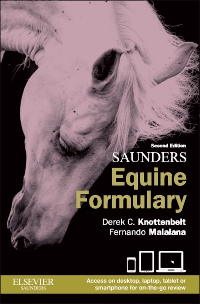
Saunders Equine Formulary - Elsevier E-book on VitalSource, 2nd Edition
Elsevier eBook on VitalSource

A handy and portable guide to today’s leading equine drugs, Saunders’ Equine Formulary, 2nd Edition makes it quick and easy to look up drug information when and where it’s needed the most — in the field. And it’s more than a simple formulary: this book also provides benchmark values on vital signs and normal values so that readers can correctly interpret diagnostic tests. This new edition is the only equine formulary available both in print and as an app for mobile use. Written by a world-renowned expert, Derek Knottenbelt, this book is an indispensable reference for equine veterinary practitioners, veterinary students, and others involved in breeding and keeping horses.
-
- NEW! A handy interactive app format allows extra-quick, point-of-care reference.
- NEW! A full-colour design includes more high-quality line drawings and adds photographs showing nerve block techniques.
- NEW! Revised clinical techniques section deals with the difficult horse and restraint methods, including field anaesthesia.
- NEW algorithmic approach updates and clarifies emergency procedures, wound management, disease control protocols, and more.
- NEW! Wound dressings and suturing sections are thoroughly modernized.
- NEW! Updates include all drugs and dosages and regulatory news.
- A listing of haematological, biochemical, physiological, and therapeutic data is contained in just one volume, designed with the final-year vet student and recent graduate in mind.
- Information on drug dosages and adverse reactions reflects manufacturers’ recommendations in data sheets and literature inserts.
- Practical, step-by-step instructions summarize principal diagnostic tests.
- Practical, universal relevance is created by the use of SI units and generic drug names — making this reference useful to everyone working in the equine field all over the world, whether vet student or equine specialist.
- Clinical Aids section provides highly practical advice and quick synopses for the most common scenarios likely to occur on a field visit, such as bandaging techniques, humane destruction, and restraint techniques.
-
- NEW! A handy interactive app format allows extra-quick, point-of-care reference.
- NEW! A full-colour design includes more high-quality line drawings and adds photographs showing nerve block techniques.
- NEW! Revised clinical techniques section deals with the difficult horse and restraint methods, including field anaesthesia.
- NEW algorithmic approach updates and clarifies emergency procedures, wound management, disease control protocols, and more.
- NEW! Wound dressings and suturing sections are thoroughly modernized.
-
Part 1: Vital Signs, Normal Values
Reference Values
Sample Collection
Reproductive DataPart 2: Diagnostic Tests
Test PerformancesPart 3: Index of Drugs Used in Equine Medicine
The Use of Veterinary Medicinal Products
Guidelines for the Use of Medicines in Equine Animals
Prescriptions
Prescription Abbreviations
Drug Categorisation for Prescription Purposes
Distribution Categories (UK) from October 2005
Section 1: Drugs Acting on Central Nervous System
Section 2: Drugs Acting on the Cardiovascular System
Section 3: Drugs Acting on the Respiratory System
Section 4: Drugs Acting on the Urinary Tract
Section 5: Drugs Acting on the Gastrointestinal Tract
Section 6: Hormones/Steroids and Non-steroidal Anti-inflammatory Drugs
Section 7: Anti-infective Drugs
Section 8: Blood Modifying Agents
Section 9: Vaccines/Antisera
Section 10: Miscellaneous Drugs/Medications and Other MaterialsPart 4: Clinical Aids
Section 1: Bodyweight and Surface Area Estimation
Section 2: Imperial-Metric Conversion
Section 3: SI Unit Conversion Factors
Section 4: Restraint of Horses
Section 5: Ageing
Section 6: Humane Destruction
Section 7: Bandaging Techniques
Section 8: Clinical Techniques
Section 9: Signs of Impending Parturition
Section 10: Neonatal Assessment and Sepsis Scoring of Foals
Section 11: Poisons and Antidotes
Section 12: Notifiable Diseases
Section 13: Investigative Methods/Protocols
Section 14: Equipment for Equine Practice
Section 15: Anaesthesia
Section 16 Current Requirements Concerning Drug Usage and Passport Regulations in the UK
Index

 as described in our
as described in our 